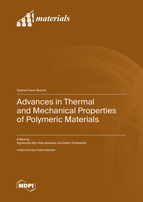Advances in Thermal and Mechanical Properties of Polymeric Materials
A special issue of Materials (ISSN 1996-1944). This special issue belongs to the section "Polymeric Materials".
Deadline for manuscript submissions: closed (20 October 2023) | Viewed by 19162
Special Issue Editors
Interests: combustion; co-combustion; thermal analysis; TG/DTG; DTA; DSC; QMS; emission of pollutants; fuels; waste; polymer materials; composites; recycling; thermomechanical properties of materials
Special Issues, Collections and Topics in MDPI journals
Interests: mechanical properties; thermomechanical properties; polymer materials; composites; thermal analysis TG/DTG; DTA; DSC; QMS; computer simulation of processes
Special Issues, Collections and Topics in MDPI journals
Special Issue Information
The purpose of this Special Issue is to publish papers that deal with the thermomechanical and electrical properties of polymers and their composites with other materials. It is important to recognize the applicability of various fillers in polymers composites, to create new composites and to modify existing composites. Advancements in the engineering of polymeric materials, including the search for innovative polymer composites with specific properties, resulted in the expansion of the area of their application, especially in the automotive, construction, energy, packaging and medical industries. The practical application of new polymeric materials requires knowledge of their mechanical, electrical and thermal properties, as well as the recognition of changes in these properties during the operation and destruction of polymers. The environmental aspect of research is important, including the combustion/co-combustion of polymers, the thermal use of polymer waste with energy recovery, as well as other uses of recycled polymer materials. It is important to conduct model studies regarding changes in the properties of polymeric materials and the computer simulation of the course of exploitation and thermal processes of polymers.
Dr. Agnieszka Kijo-Kleczkowska
Dr. Adam Gnatowski
Guest Editors
Manuscript Submission Information
Manuscripts should be submitted online at www.mdpi.com by registering and logging in to this website. Once you are registered, click here to go to the submission form. Manuscripts can be submitted until the deadline. All submissions that pass pre-check are peer-reviewed. Accepted papers will be published continuously in the journal (as soon as accepted) and will be listed together on the special issue website. Research articles, review articles as well as short communications are invited. For planned papers, a title and short abstract (about 100 words) can be sent to the Editorial Office for announcement on this website.
Submitted manuscripts should not have been published previously, nor be under consideration for publication elsewhere (except conference proceedings papers). All manuscripts are thoroughly refereed through a single-blind peer-review process. A guide for authors and other relevant information for submission of manuscripts is available on the Instructions for Authors page. Materials is an international peer-reviewed open access semimonthly journal published by MDPI.
Please visit the Instructions for Authors page before submitting a manuscript. The Article Processing Charge (APC) for publication in this open access journal is 2600 CHF (Swiss Francs). Submitted papers should be well formatted and use good English. Authors may use MDPI's English editing service prior to publication or during author revisions.
Keywords
- thermomechanical and electrical properties of polymers and composites
- structure of polymeric materials
- combustion of polymeric materials
- co-combustion of polymeric materials with fuels and waste
- thermal analysis TG/DTG, DTA, DSC, QMS of polymers and composites
- emission of pollutants during thermal processes
- modeling and computer simulation of polymeric materials properties change
- modeling and computer simulation of exploitation and thermal processes
- recycling of polymeric materials








